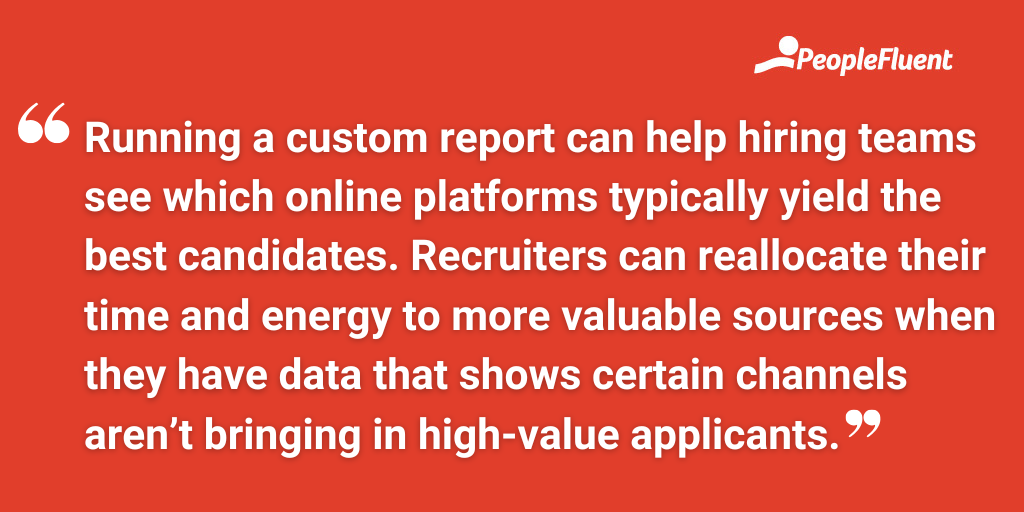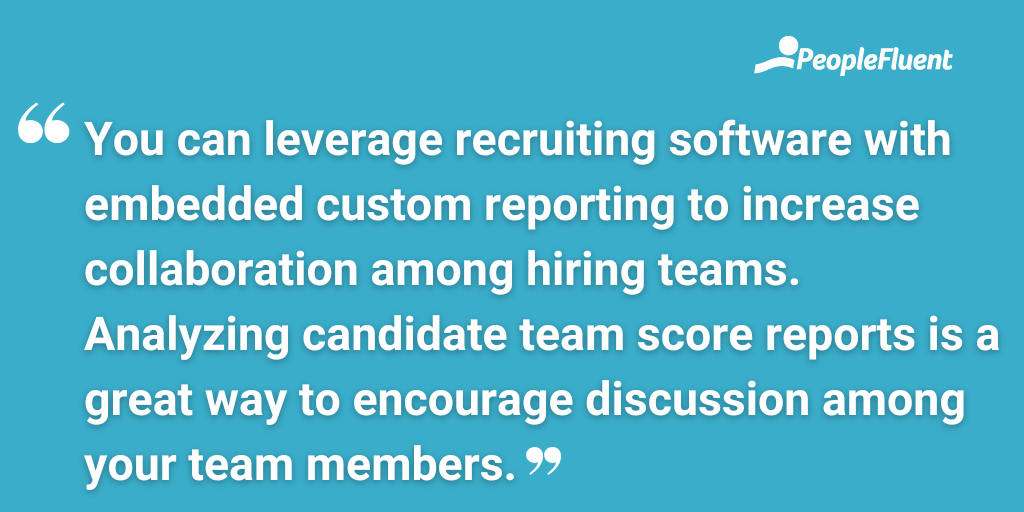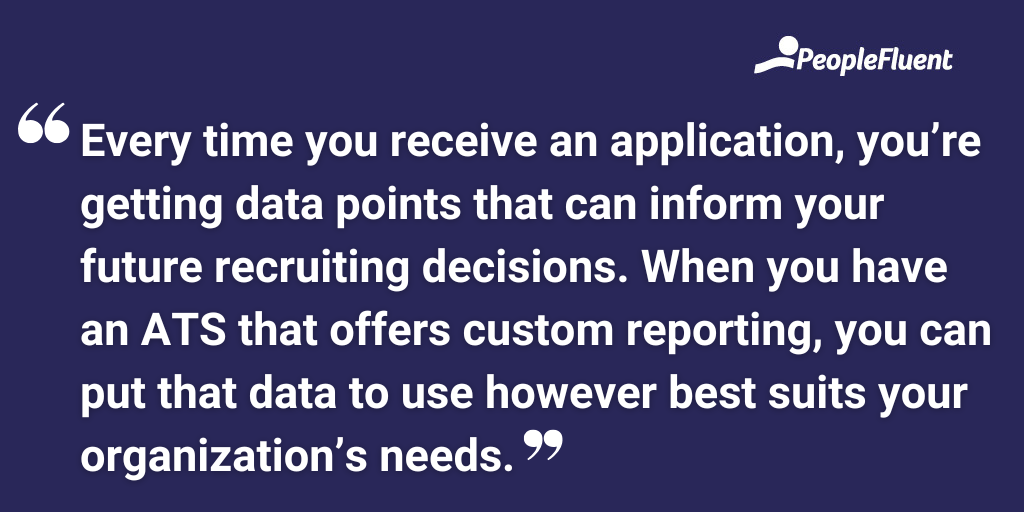Published: Mar 8, 2023Time to read: 6mins Category: Insights
4 Ways Custom Reports Improve Your Recruiting Practices
Everyone wants to hire the best of the best, but if you’re not leveraging the data in your applicant tracking system (ATS), you could be missing out. Scanning resumes for target keywords in your job descriptions isn’t enough anymore. Though most applicants wouldn't be able to tell you what an ATS is, they're more than familiar with the basic functions of such systems, and they know which terms to scatter throughout their resumes to get their names at the top of your list. Luckily, robust recruiting software with custom reports can help you find the real diamonds in the rough.
Just as candidates’ skills and backgrounds are unique, so too are your organization’s needs. Your recruitment software will likely let you run a set of standard reports that offer a generic picture of applicant data. Custom reporting lets you target specific candidate information. When your talent acquisition team actively targets certain data points, you get a more precise measure of success for your recruiting efforts. Data precision helps organizational leaders allocate resources more effectively to better align with business goals.
Additionally, leaders can use the information retrieved via custom reporting to make the recruiting process feel more personal for candidates and more engaging for hiring teams. Simply put, these reports let you customize your strategies and make your recruitment efforts more effective.
We’ve outlined four ways custom analytics reports can improve your recruiting practices below.
1) Understand Where Candidates Come From
When a position opens at your company, you probably don’t post the job to your organization’s career site and call it a day. Instead, you likely use a combination of job boards and aggregators, social media, referrals, and even career fairs to spread the word about your available opportunities.
As applications come in and you start to assess which candidates might be a strong fit for the position, you’ll want to track which channels bring in the highest quality job seekers. It’s important to know where the strongest candidates come from when job sourcing, but where can mean both:
- An applicant’s physical location, and;
- How an applicant finds your job posting
Custom reporting gives you the option to perform a sourcing analysis, so your talent team can spend its time and energy on the channels that typically yield the greatest results.

HANDPICKED FOR YOU | ‘5 Can’t-Miss Recruiting Trends for 2023’
Maybe you’re using college job fairs to target entry-level positions. A custom report using recruitment analytics will generate a candidate volume map that displays each candidate’s physical location. This kind of heat map can quickly identify which university populations most frequently produce the highest-quality candidates. With this information, your team might decide to spend more resources in certain geographic areas based on this data.
Likewise, this approach can be used to do a source analysis for your online recruitment channels. There are seemingly endless platforms for posting open positions. You could spend hours promoting your open jobs on each available platform, not to mention the time it would take to review the applications from so many different sources.
Running a custom report can help hiring teams see which online platforms typically yield the best candidates. Recruiters can reallocate their time and energy to more valuable sources when they have data that shows certain channels aren’t bringing in high-value applicants.
2) Define High-Quality Candidates
How you define a high-quality candidate will depend on your organization and the requirements of the position you’re trying to fill. It’s likely that many applicants could be an adequate fit for the same position, so it’s important to define “high quality” for your circumstances. Luckily, custom reports can help.
When a person applies for a position, tracking analytics will follow that applicant’s journey throughout the hiring process—no matter how far into the process they might go. Each member of the hiring team who interacts with a candidate can input their remarks and scores. The candidate will also receive a team score based on cumulative feedback. A custom report through your recruiting analytics software will then show you which people are the highest-quality candidates for that position.

KEEP READING | ‘Highly Configurable & Candidate-Friendly: Why You (And Your Applicants) Win With PeopleFluent Recruiting’
3) Encourage Active Engagement Among Hiring Teams
Posting to job boards and sorting through resumes can easily start to feel like a passive process. Fortunately, recruiting technologies can help HR leaders encourage active engagement among their talent acquisition teams.
You can leverage recruiting software with embedded custom reporting to increase collaboration among hiring teams. Analyzing candidate team score reports is a great way to encourage discussion among your team members. Before you offer to bring on a new hire, it’s essential to make sure everyone on the team feels comfortable with the decision. Plus, actively communicating about your hiring process is likely to foster further collaboration in the future.
You can even add a touch of fun to the process with gamified recruiting technologies. Recruiting software with shareable dashboards can liven up your process by encouraging recruiters to “compete” with one another. You can use the data from your reports to set goals for your team and incentivize success by measuring metrics like quality of (and time to) hire.
4) Control How Data Is Presented—and Who Has Access
When your talent acquisition team needs to make the case for an operational shift, it’s imperative you have data to back your ideas. Recruiting analytics allows you to control how you view and present your data, in addition to customizing which information you include in your reports. Having this option is especially useful when presenting to organizational leaders. You can choose from an array of visualizations that will be easy for your audience to digest and understand, so they’ll spend less time puzzling over the numbers and more time listening to your plan.
Of course, you don’t want just anyone accessing your candidate data. That’s why recruiting software with custom reporting gives talent teams more control over who’s accessing applicants’ information.
In addition to gamifying the recruitment process, talent teams can use recruiting dashboards to generate private and public reports, ensuring the right people have the information they need to make informed decisions for the organization without compromising privacy.

RELATED READING | ‘Visualizations and Metrics That HR Leaders Love’
Let Your Data Work for You
Every time you receive an application, you’re getting data points that can inform your future recruiting decisions. When you have an ATS that offers custom reporting, you can put that data to use in a way that best suits your organization’s needs. Whether you’re trying to find the best candidate for a position or improve your hiring process, leveraging the full power of custom reporting helps you achieve your goals.
Discover the Full Power of Recruiting Analytics
Ready to learn more? Download our ebook, ‘Refresh Your Recruiting Strategy: How Leveraging Recruiting Analytics Lands You High-Quality Talent,’ or request a demo today.